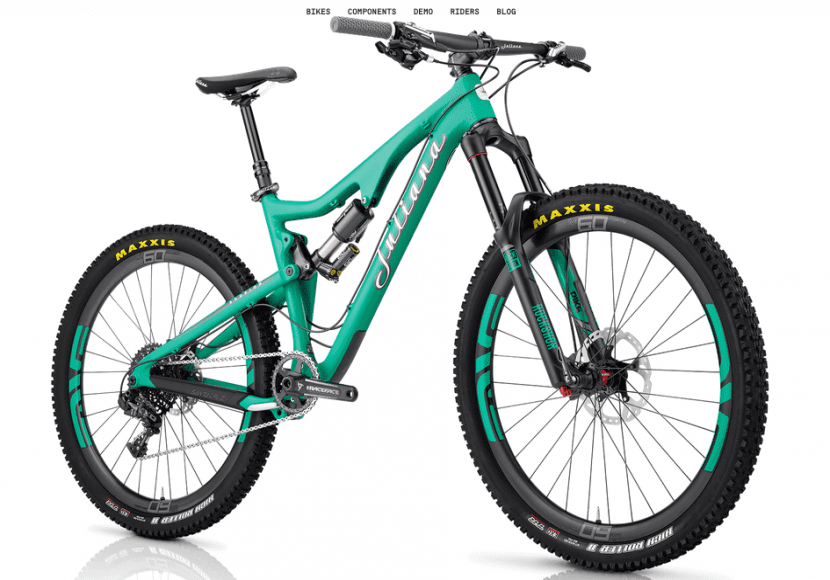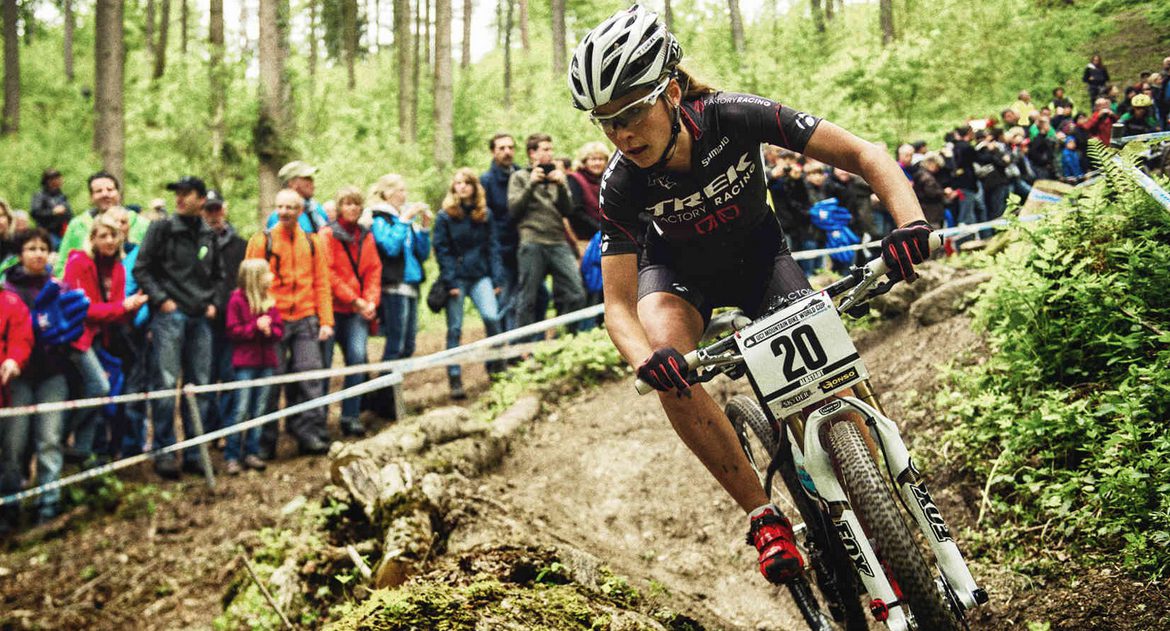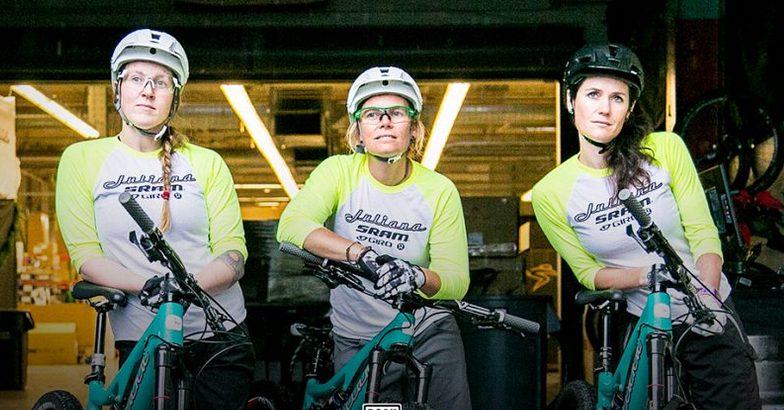June 12, 2015

By Kristen Gross, Sacred Rides contributor
There was a time when choosing a women’s specific bike meant choosing something second best. The frames were heavy, built up with lower-end components, and the geometry put women in such an upright position, it was hard to take the bikes seriously.
Those days are over.
With the popularity of mountain biking growing among females, for the first time, manufacturers have the demand they need to create bikes that help women of all abilities make the most of their ride. Women have discovered mountain biking as a way to connect with each other, have adventures, challenge themselves, see beautiful things, and travel the world. And they have the full attention of the bicycle industry.
“The women’s market is just now maturing to the point where we can have greater differentiation,” said Ross Rushin, Trek’s assistant brand manager. “We’re definitely seeing it’s a big disservice to women to lump us all into one category.”
Whether a rider is a beginner, with a smaller budget, who is picking out a bike for thefirst time; or she’s an expert shredder, looking for a race-worthy bike that comes with all the top-end components, she can find a bike that works for her. So is a women’s specific bike the right choices for you? Here are a few things to look for to help you decide.
Technology

Trek is one brand that is pushing the envelope on what makes a bike women’s specific. On its popular Lush trail bike, it has included a custom version of its new RE:aktivshock, complete with a higher leverage ratio, meaning smaller riders can more easily activate the suspension. “Lighter-weight riders don’t have to run lower-than-ideal shock pressures, which is what usually happens when you put them on a regular bike,” explained Ross Rushin, Trek’sassistant mountain bike brand manager. “It’s not the PSI the shock was designed for, soby having that higher leverage ratio, we’re able to use average shock pressures for the best performance.”Having a shock that works for a rider as intended helps increase their confidence as it soaks up the bumps and rocks on the trail; with RE:aktiv and its regressive damping, the rear wheel sticks to the ground.
FRAME CONSTRUCTION
Liv—the new women’s only brand that was once a sub-brand of Giant—not only created a frame with women’s specific geometry, they built it using a special carbon lay-up process that allowed them to cut unnecessary weight. The Lust Advanced 0 comes in at just over 22 pounds—an impossibly low figure for a full-suspension bicycle. For women, this is an especially big deal. It’s a question of biology, math and physics: women develop less power to weight than men, so the lighter the bike, the more she’ll feel like she has the control she needs to gain confidence. That means, if you’re a woman choosing between two bikes, and one is lighter than the other, choose that one.
GEOMETRY
The trick with frame geometry is to select a bike that fits you because you’re you. Not because you’re a woman. Part of the joy of shopping for a bicycle—especially if you’re about to take it on a bucket-list worthy adventure—is finding the one that works for you and your riding style.
Bikes with women’s specific frames have some standard features based on universal averages. For example, a shorter top tube, and a shorter standover work to bring a woman’s center of gravity forward, complimenting the way women tend to ride: more from the legs, than by muscling the bike with their upper bodies as men tend to do.
One of the things that will help your handling is to bring your center of gravity down. The lower you can go, the more stable you will be. Naturally, the laws of gravity apply equally to men and women. One of the ways you can get lower is to get longer, so an experienced woman, even with an on-average shorter torso, will benefit from being lengthened over a regular top tube.
However women’s specific or otherwise, there is no “one size fits all” so it’s crucial that you spend time trying out bikes—and yours might not be from the women’s side of the catalogue! It’s especially effective if you can rent one for a trail ride, trip or try one on a demo day.
CONTACT POINTS
For some riders, all that’s needed to make a bike more female-friendly are a few small changes. The thinking is that all of us—not just women—have different body shapes so it’s not necessary to design a frame that caters to women specifically, but including those smaller touches can make the ride more comfortable for her.
Manufacturers like Scott and Norco (who carry the women’s specific “Contessa” and “Forma” models, respectively) know this and besides adding feminine paint jobs to popular “men’s” frames, they add women’s specific saddles and grips. They also spec a narrower handlebar, though again, this is something you’ll want to test for fit.
MARKETING

Juliana, the little sister brand to Santa Cruz, is the world’s first women’s only mountain bike brand. The bikes are renamed, repainted versions of popular Santa Cruz originals like the 5010 (Furtado) and the Bronson (Roubion).
“The Juliana brand gives us our own platform to rally behind women in the sport and to bring groups of rad women together over the thing we all have in common—bikes,” says Juliana Brand Manager, Katie Zaffke. “It gives us something bigger to be a part of—a bike, an adventure, an experience, a community, a spirit, and an allure that is just for us, uniquely our own.”
While some might dismiss it as merely marketing, the women’s‑specific focus—when executed genuinely—serves as both an inspiration and an invitation. The Juliana website and branding are visually beautiful experiences. For the first time, we’re seeing images of women jumping out of helicopters, experiencing adventure, and ripping big, sweet lines.
The images, colors, and even logos, help more women see themselves in the sport and feel like they belong—an important part of bringing more women into a sport that’s been dominated by men for so long.
BOTTOM LINE
For women in mountain biking, there has never been such a wide range of choices, or as many opportunities to get a bike that’s as close to a custom fit as you can get without hiring your own team of engineers.
As more women come to the sport, the resources devoted to women’s specific technologies and equipment will only increase to keep up with demand. Engineers are working every day to find improvements that will help make women’s riding even more enjoyable. The momentum is here. And it’s an exciting time to be a woman in mountain biking.
About Kristen
Kris is a Canuck living in California who loves bicycles, all sorts. She combines her passion for writing and riding by working as a freelancer for clients in the cycling and outdoor industries, and as a contributor for popular sites like MTBR.com, TetonGravity.com, and RoadBikeReview.com. She is also an XC racer, coach and skills instructor.
